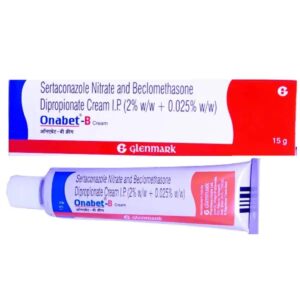DICLOFENAC + BECLOMETHASONE + SERTACONAZOLE NITRATE
Diclofenac: Diclofenac is a nonsteroidal anti-inflammatory drug (NSAID) that is commonly used to reduce pain, inflammation, and swelling. It is available in oral tablet, capsule, oral solution, and topical gel forms.
Diclofenac works by inhibiting the production of prostaglandins, which are substances that can cause pain and inflammation in the body. By reducing levels of prostaglandins, diclofenac helps to alleviate pain and reduce inflammation.
The dose of diclofenac depends on the condition being treated and may vary for different individuals. It is important to follow the instructions provided by the healthcare professional or the medication label. The usual starting dose for oral diclofenac is typically 50 mg 2-3 times per day, but this may be adjusted based on the individual’s response and needs.
Some common side effects of diclofenac include nausea, stomach pain, heartburn, diarrhea, constipation, dizziness, and headache. It may also cause stomach ulcers, bleeding, or perforation, especially in high doses or with long-term use. The risk of these side effects is higher in elderly individuals and those with a history of stomach ulcers or gastrointestinal bleeding.
Diclofenac is contraindicated in individuals who have had allergic reactions or hypersensitivity to the drug or other NSAIDs. It should be used with caution in individuals with pre-existing gastrointestinal, cardiovascular, renal, or hepatic conditions. Long-term use of diclofenac should be avoided unless it is necessary and the benefits outweigh the risks.
Additionally, diclofenac can interact with other medications, including blood thinners, diuretics, and certain antidepressants. It is important to inform the healthcare professional about all medications being taken to avoid potential drug interactions.
In summary, diclofenac is an NSAID used to relieve pain, reduce inflammation, and alleviate swelling. It works by inhibiting the production of prostaglandins. The dose and duration of treatment should be determined by a healthcare professional based on the individual’s condition. While side effects are possible, they can typically be managed with appropriate monitoring and medical advice.
Beclomethasone: Beclomethasone is a synthetic corticosteroid medication used primarily as an inhaler for the treatment and prevention of various respiratory conditions, such as asthma, chronic obstructive pulmonary disease (COPD), and allergic rhinitis.
The drug works by reducing inflammation in the airways and suppressing the release of substances in the body that cause inflammation, leading to improved breathing and reduced symptoms. Beclomethasone acts locally in the respiratory system and has minimal systemic effects when used as an inhaler.
The usual dose of beclomethasone inhaler for adults and children 12 years and older is 40-160 micrograms (mcg) twice daily. However, the specific dose may vary depending on the severity of the condition and the individual’s response to treatment. It is important to follow the prescribed dose and instructions from a healthcare professional.
Common side effects of beclomethasone inhaler may include throat irritation, hoarseness, cough, headache, and fungal infections in the mouth or throat (oral thrush). Rinsing the mouth with water after each use can help reduce the risk of developing thrush. These side effects are generally mild and temporary.
It is important to note that beclomethasone is not a rescue medication for sudden asthma attacks. A short-acting bronchodilator should be used for immediate relief in such situations. Beclomethasone is meant for regular use to manage and prevent symptoms over a longer period.
As with any medication, it is essential to discuss with a healthcare professional or pharmacist about any potential drug interactions or individual contraindications before starting beclomethasone. They can provide personalized advice and guidance based on the specific needs and medical history of the individual.
Sertaconazole Nitrate: Sertaconazole nitrate is an antifungal medication used to treat fungal skin infections such as tinea corporis (ringworm), tinea cruris (jock itch), and tinea pedis (athlete’s foot). It is available in the form of a cream or lotion.
The mechanism of action of sertaconazole nitrate involves inhibiting the synthesis of ergosterol, an essential component of fungal cell membranes. Without ergosterol, the fungal cells become weakened and more susceptible to destruction. This action effectively kills or inhibits the growth of the fungi causing the infection.
The recommended dose of sertaconazole nitrate cream or lotion is typically a thin layer applied to the affected area once or twice daily, as directed by a healthcare professional. It is important to clean and dry the affected area before applying the medication.
Like any medication, sertaconazole nitrate may cause side effects. Common side effects include mild skin irritation or burning sensation at the application site. These effects are usually temporary and not severe. If any severe side effects occur, such as allergic reactions (rash, itching, swelling, severe dizziness, difficulty breathing), it is important to seek immediate medical attention.
It is worth noting that sertaconazole nitrate may interact with other medications, and it may not be suitable for everyone. It is advisable to consult a healthcare professional or pharmacist before using sertaconazole nitrate, especially if there are any pre-existing conditions or concurrent use of other medications. They will provide guidance on the appropriateness of this medication and ensure there are no contraindications or potential drug interactions.

